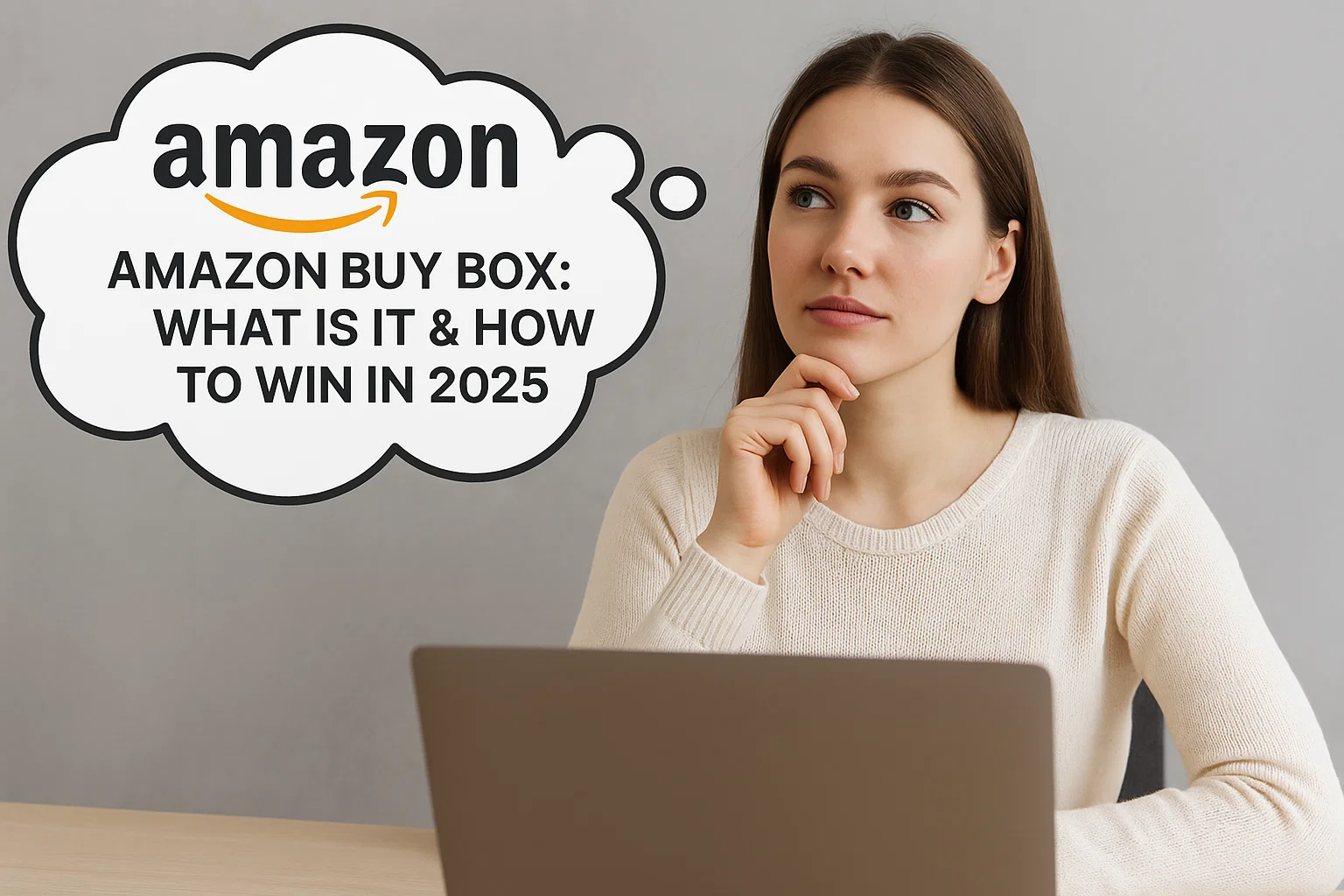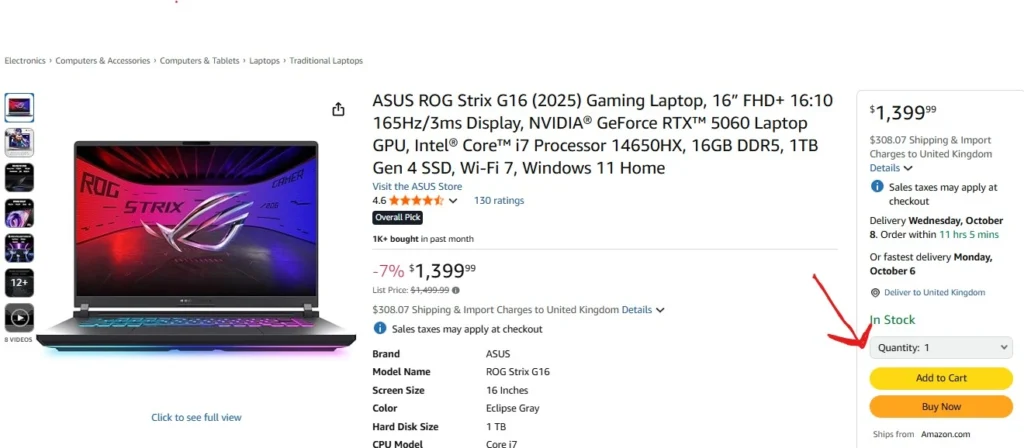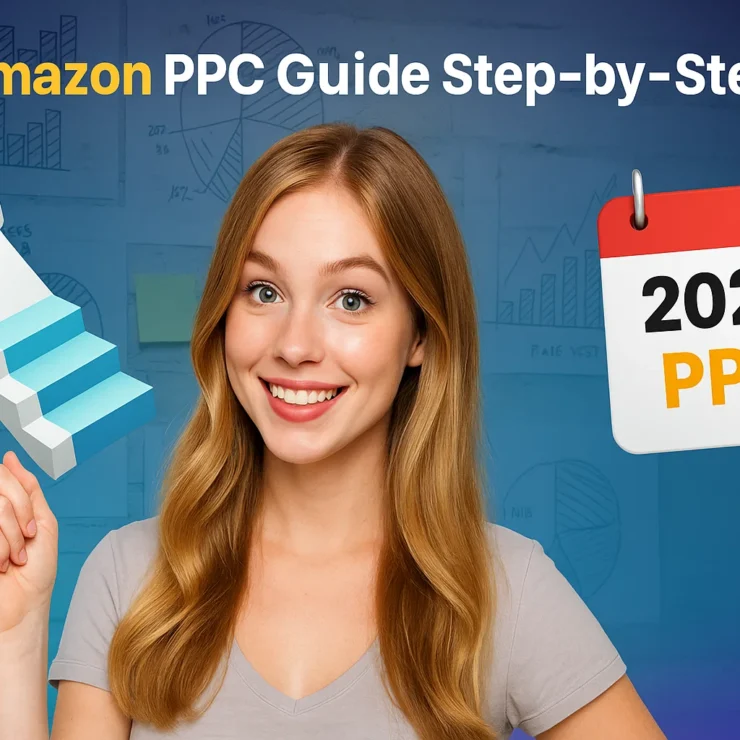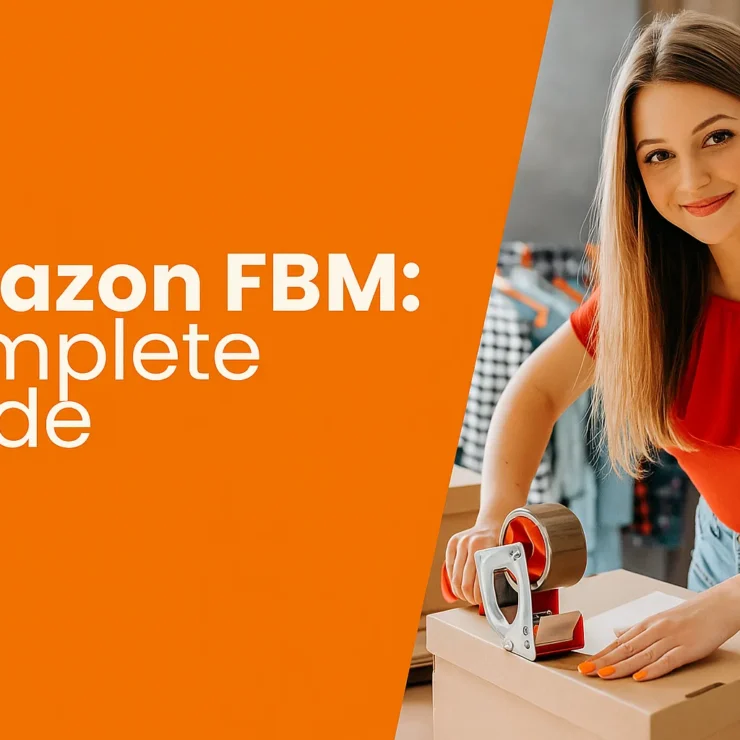If you’re selling on Amazon, you’ve probably come across the term “Buy Box” more than once. But what exactly is the Buy Box, and what does it mean to secure it?
Whether you’re a newcomer trying to understand the concept or a seasoned seller aiming to boost your chances of winning the Buy Box, this guide will explain everything you need to know—from what the Buy Box is to how you can win it in 2025.
Let’s dive in!
Save time and scale efficiently with the top Amazon FBA automation companies of 2025 offering powerful business growth solutions.
What is the Amazon Buy Box?
The Amazon Buy Box is the white box on the right-hand side of a product detail page. Here, customers can see price, delivery details, quantity selector, and directly add items to their cart or purchase them instantly with the “Buy Now” button.
Since multiple sellers may offer the same product, only one of them “wins” the Buy Box at any given time. This seller’s offer becomes the default purchase option — meaning most shoppers won’t even scroll down to see other sellers.
Amazon rotates the Buy Box between eligible sellers, but the lion’s share of sales goes to whoever holds it most often. In fact, industry studies show that over 80% of Amazon sales happen through the Buy Box, making it one of the most critical factors in a seller’s success.
In short, if you want to scale your Amazon business, understanding and optimizing for Amazon Buy Box wins is non-negotiable.
Discover what Amazon Attribution is and how sellers can use it in 2025 to track and optimize marketing campaigns.
Why Amazon Buy Box Wins Matter in 2025
Winning the Amazon Buy Box has always been important, but in 2025 it’s more critical than ever. The Buy Box is the main driver of visibility, credibility, and sales on Amazon. If you’re not in it, you’re likely missing out on the majority of conversions.
The Buy Box Drives Sales
Studies consistently show that most purchases on Amazon happen through the Buy Box. Shoppers rarely scroll down to check other sellers because the Buy Box is designed for convenience — one click to purchase. On mobile devices, which now dominate online shopping, the Buy Box often takes up the entire first screen, making alternative offers nearly invisible.
It’s Tied to Advertising and Promotions
Amazon links Buy Box ownership directly to ad eligibility. If you don’t win the Buy Box, your Sponsored Product ads may not display at all, regardless of how much you bid. This makes Buy Box performance the gatekeeper not just for organic sales, but for paid visibility too. Losing it can immediately limit your ability to scale through advertising.
It Builds Trust With Shoppers
When customers see your offer in the Buy Box, they associate it with reliability. Amazon’s algorithm favors sellers with strong metrics — fast shipping, accurate tracking, low return rates — which reassures buyers that they can shop with confidence. In competitive niches, being the default Buy Box winner can be the difference between a shopper choosing you or abandoning the purchase.
Competition Is Tougher in 2025
Amazon continues to refine its Buy Box algorithm. Price still matters, but it’s no longer the only factor. Performance metrics, fulfillment method, and even stock availability can influence who wins. With competition higher than ever, sellers need to approach Buy Box optimization as a core part of their business strategy.
Learn what Amazon BSR means and how this crucial ranking metric affects product visibility and long-term sales success.
Amazon Buy Box: Eligibility Requirements for Sellers
Becoming eligible to compete for the Amazon Buy Box (also known as the Featured Offer) requires meeting several baseline requirements. Meeting these does not guarantee you will always win the Buy Box, but they are mandatory prerequisites. Below are the key criteria as of 2025.
Professional Seller Account
Only sellers with a Professional selling plan are eligible to compete for the Buy Box. Individual seller accounts (pay-per-item) are excluded from Buy Box eligibility.
Offer Condition Must Be “New”
The products you list and want to compete in must be in new condition. Used, refurbished, or collectible offers generally do not qualify under the main Buy Box eligibility criteria.
Consistent Performance Metrics
Amazon monitors key seller performance metrics. If these thresholds are not met, your ability to become Buy Box eligible is compromised:
Order Defect Rate (ODR) — must be very low (often under ~1 %).
Late Shipment Rate (LSR) — must remain low; consistently late shipping is disqualifying.
Pre-Fulfillment Cancellation Rate — the percentage of orders canceled before shipment should be minimal.
Valid Tracking Rate (VTR) — high proportion of your shipped orders must have valid tracking.
On-Time Delivery Percentage — deliveries should meet or exceed expected delivery windows.
Customer Feedback / Rating — strong positive feedback and review history help maintain eligibility.
These metrics show Amazon you are reliable and trustworthy.
Inventory Must Be In Stock & Available
You cannot qualify if your inventory goes out of stock frequently. Amazon favors sellers who keep consistent stock levels and avoid “out-of-stock” situations. Running out of inventory (or having delayed restocks) can cost you Buy Box eligibility or rotation.
Competitive Pricing (Landed Price)
Your total price (product price + shipping) must be competitive relative to other offers. Amazon refers to this as the “landed price.” If your price is substantially higher, your offer may be excluded entirely from Buy Box rotation.
Account Health & Compliance
Your account must be in good standing (no active suspensions or policy violations).
Past or current violations (late performance, customer complaints, A-to-z claims) may render you ineligible until resolved.
Amazon sometimes enforces a “probationary period” or “guard rail” for new sellers, meaning new accounts may not be eligible immediately.
Sales & Activity History
Amazon prefers sellers with some track record. A new product listing may not immediately win the Buy Box until it achieves a certain level of sales or reviews. Some sellers report needing at least one review or evidence of sales before Buy Box becomes active.
Checking Buy Box eligibility step-by-step
Step 1:
Go to your Seller Central account. Hover over the “Inventory” tab at the top, then click on “Manage Inventory.”
Step 2:
On the inventory page, look for the “Preferences” button in the top-right corner and click it.
Step 3:
In the Column Display settings, find the option called “Featured Offer Eligible” (sometimes called “Buy Box Eligible”). Check the box next to it, then click Save.
Step 4:
Now, your inventory list will show a new column called “Featured Offer Eligible.”
Step 5:
Use the search bar to find the product you want to check. You can search by product title, ASIN, or SKU. In the new column, it will show “Yes” if your listing is eligible for the Buy Box, or “No” if it’s not.
A step-by-step guide on how to create an Amazon Storefront in 2025 to boost brand identity and customer trust.
What Factors Influences the Amazon Buy Box?
| Factor | What Amazon Looks At | Ideal Benchmarks / Best Practices |
|---|---|---|
| Pricing (Total/Landed Price) | Includes item cost + shipping + handling + taxes. Amazon doesn’t just favour the lowest product price—it wants the full delivered cost to the customer to be competitive. | Use repricing tools to stay within ~5% of the lowest landed offer when possible without hurting margins. |
| Fulfillment Method / Delivery Speed | Options like FBA (Fulfilled by Amazon) or SFP (Seller‑Fulfilled Prime) are preferred because they ensure fast, reliable shipping. Amazon tracks promised vs. actual delivery windows. | If using FBM, keep shipping time short, ideally 1‑3 business days. For many categories, speed can compensate even if not using FBA. |
| Order Defect Rate (ODR) | This combines negative feedback, A-to-Z Guarantee claims, and chargebacks. Amazon reviews both recent and longer‑term history. | Keep ODR under ~1%. Exceeding that usually disqualifies you or heavily reduces Buy Box share. |
| Late Shipment Rate (LSR) | If orders are frequently shipped late, it affects your credibility in Amazon’s algorithm. | Aim for under ~4% late shipments. Faster dispatch and realistic ship‑by times help. |
| Valid Tracking Rate (VTR) | Orders with reliable tracking show Amazon that you’re transparent and dependable. | Above ~95% of your orders should have valid tracking. |
| In‑Stock / Inventory Availability | Amazon favors sellers who don’t go out of stock often. Being out of stock makes you temporarily ineligible. | Maintain enough stock; use tools to monitor inventory. Even short stockouts hurt momentum. |
| Customer Feedback & Seller Rating | Ratings over the past 30, 90, and 365 days matter. Both the score (percentage positive) and the number of reviews are used. Also, speed of responses to customer queries matters. | Aim for ≥ 90‑95% positive feedback, more reviews if you’re newer. Respond to messages quickly (within 12‑24h) to avoid penalties. |
Successful sellers rely on Amazon product research in 2025 to find winning products and gain a competitive edge.
Step-by-Step Guide: How to Win the Amazon Buy Box in 2025
Winning the Amazon Buy Box isn’t about a single trick — it’s about aligning with Amazon’s ultimate goal: delivering the best shopping experience for customers. The Buy Box algorithm weighs multiple factors, and sellers who consistently meet Amazon’s standards have the edge. Here’s how to do it in 2025:
Keep Pricing Competitive (But Smart)
Price is one of the strongest Buy Box signals, but “cheapest” doesn’t always win. Amazon looks at the landed price (item price plus shipping). Use automated repricing tools or Amazon’s built-in repricer to stay competitive, but set floor prices to protect your margins. Small price gaps often don’t matter if you excel in other performance areas.
Choose the Right Fulfillment Method
Amazon’s algorithm heavily favors sellers who can guarantee fast, reliable shipping.
FBA (Fulfillment by Amazon): The safest bet. Amazon handles storage, shipping, and customer service, and you get the Prime badge automatically.
SFP (Seller Fulfilled Prime): Works if you have excellent logistics. But the requirements are strict (same-day or next-day shipping, weekend coverage, etc.).
FBM (Fulfilled by Merchant): You’re in full control, but you’ll need flawless on-time delivery, accurate tracking, and responsive support to stay competitive.
In 2025, Prime eligibility is more important than ever, so FBA remains the easiest route to consistent Buy Box wins.
Maintain Healthy Inventory Levels
Running out of stock doesn’t just lose you the Buy Box — it can hurt your sales history, which Amazon also considers. Use Seller Central’s inventory dashboards, set up stock alerts, and plan ahead for seasonal spikes. Reliable availability builds Buy Box trust.
Improve Seller Performance Metrics
Your Account Health metrics directly influence Buy Box wins. Keep these in check:
Order Defect Rate (ODR): Stay well below 1%.
Pre-Fulfillment Cancellation Rate: Under 2.5%.
Late Shipment Rate: As close to 0% as possible.
Valid Tracking Rate & On-Time Delivery: Essential for FBM sellers.
Every interaction counts — even small slips can push the Buy Box to competitors.
Deliver Excellent Customer Service
Customer satisfaction is a quiet but powerful Buy Box lever. Reply to messages within 24 hours, resolve disputes quickly, and encourage positive reviews. The fewer complaints and claims tied to your account, the stronger your Buy Box eligibility.
Watch Out for Competition & Unauthorized Sellers
If multiple sellers share a listing, unauthorized resellers can undercut prices or damage the listing with poor service. Monitor your listings, file infringement claims if necessary, and protect your brand reputation to stay competitive.
Continuously Monitor & Adapt
The Buy Box isn’t permanent — it rotates between sellers based on real-time performance. Use Buy Box tracking tools to measure your Buy Box Percentage (the share of time you own it), and adjust pricing, fulfillment, or stock accordingly.
Discover how Amazon Merch on Demand in 2025 empowers creators to monetize designs without upfront inventory costs.
The Suppressed Buy Box
If you’ve ever looked at one of your listings and noticed that the Buy Box button is missing, you’ve experienced what Amazon calls a Suppressed Buy Box. Instead of the familiar “Add to Cart” option, customers only see “See All Buying Options.” This might sound small, but in reality, it can drastically reduce your sales.
So why does Amazon suppress the Buy Box? It all comes down to protecting the customer experience. If Amazon feels that the offers on a listing aren’t competitive enough or don’t meet its performance standards, it will withhold the Buy Box. Here are the most common reasons:
Uncompetitive Pricing: If your product price is significantly higher than recent sales history or other retail channels, Amazon may suppress the Buy Box.
Poor Seller Metrics: Late shipments, cancellations, or a high Order Defect Rate can lead to suppression.
Low or Inconsistent Inventory: Running out of stock frequently can signal unreliability, causing the Buy Box to disappear.
Listing Quality Issues: Missing product details, poor images, or incorrect categorization can trigger suppression.
How to Fix a Suppressed Buy Box
If your listing is suppressed, don’t panic — there are concrete steps you can take:
Review Pricing: Compare your price (including shipping) to competitors and external marketplaces. Adjust if necessary.
Improve Metrics: Focus on shipping on time, reducing cancellations, and providing stellar customer service.
Check Listing Quality: Ensure your product title, description, images, and attributes meet Amazon’s standards.
Maintain Stock: Keep healthy inventory levels to avoid gaps that may trigger suppression.
In short, a suppressed Buy Box is Amazon’s way of nudging sellers to improve. By fixing pricing, inventory, and performance issues, you can restore the Buy Box and keep your sales flowing.
To better understand your ad performance on Amazon, check out our guide on how to calculate ACoS in 2025.
Ways You can Lose the Buy Box on Amazon
Winning the Buy Box isn’t permanent — even top sellers can lose it if they slip on key performance factors. Here are the most common ways you can lose it:
Uncompetitive Pricing – If your product price (including shipping) becomes higher than competitors or market trends, Amazon may award the Buy Box to another seller.
Poor Seller Metrics – High order defect rates, late shipment rates, or frequent cancellations can hurt your chances of keeping the Buy Box.
Low or Inconsistent Inventory – Running out of stock or frequently going “out of stock” can cause Amazon to give the Buy Box to another seller with better inventory reliability.
Slow Fulfillment – Delays in shipping or not meeting Amazon Prime delivery standards can cost you the Buy Box, especially if competitors offer faster delivery.
Negative Customer Feedback – A drop in feedback scores or a surge in negative reviews can signal poor performance, causing you to lose the Buy Box.
Policy Violations – Breaching Amazon’s selling policies, listing guidelines, or performance standards can result in losing Buy Box eligibility entirely.
In short, staying competitive, maintaining stellar performance, and delivering excellent customer experiences are crucial to holding on to the Buy Box. Even a small slip in any of these areas can hand it over to a competitor.
A complete guide to Amazon Brand Registry in 2025 and how it helps protect and grow your brand.
How to Calculate Your Buy Box Percentage?
Buy Box percentage (also called “Buy Box win rate” or “Featured Offer %”) tells you how often your offer appears in the Buy Box compared to all times the listing was viewed.
Here’s the basic formula:
Buy Box % = (Number of times you won the Buy Box) ÷ (Total page views for that listing) × 100
So, for example:
If your offer is in the Buy Box 70 times out of 100 times people view the listing, your Buy Box percentage is 70%.
If you win 30 times in 100, it’s 30%.
Important Notes & Details
Amazon shows your Buy Box percentage in Seller Central over 2-day and 30-day periods.
It depends on “glance views” (i.e. times buyers looked at the product page while active).
If your listing has no page views, it may not count in the calculation.
Because Buy Box can rotate between sellers, your percentage may change frequently depending on competition.
Master Amazon’s image requirements and optimize product photos to improve your listings’ performance and visibility
Conclusion: Amazon Buy Box Wins
Winning the Amazon Buy Box in 2025 is no longer just an advantage — it’s a necessity for sellers who want to scale their business. With the majority of sales happening through the Buy Box, mastering how it works, staying competitive with pricing, and maintaining excellent seller performance are all key to success.
By focusing on eligibility requirements, optimizing fulfillment, monitoring your Buy Box percentage, and avoiding the pitfalls that lead to suppression, you can dramatically increase your chances of Buy Box wins. Remember: consistency and proactive management are what set successful sellers apart.
The Buy Box isn’t a mystery — it’s a system designed to give Amazon shoppers the best possible experience. If you align your business with that goal, the wins will follow.
Discover how to sell on Amazon without holding inventory, and start your business in 2025.
Frequently Asked Questions: Amazon Buy Box Wins
What is a Buy Box in Amazon?
The Buy Box is the white box on an Amazon product detail page where customers can directly add items to their cart or buy instantly. It gives featured sellers a massive advantage since most buyers purchase through it.
What does Buy Box wins 100 mean?
If your Buy Box win rate is 100%, it means your offer held the Buy Box every time it was eligible during the reporting period. Essentially, you fully dominated the listing.
Can a new seller win the Amazon Buy Box?
Yes. New sellers can win the Buy Box if they meet Amazon’s eligibility requirements, such as competitive pricing, strong fulfillment, and good account health. However, established sellers with strong metrics often have an edge.
Does Amazon always win the Buy Box?
No. While Amazon Retail often wins when it sells the same product, third-party sellers can and do win the Buy Box — especially if they have better pricing, Prime shipping, or higher seller performance.
Why is there no Buy Box for my product?
If there’s no Buy Box on a product listing, it usually means Amazon has suppressed the Buy Box due to high prices, poor product data, or policy issues. This happens when Amazon believes the offer doesn’t provide good value or experience for customers.
Power Your Brand. Automate Your Growth. Win on Amazon — with Stores Automation
At Stores Automation, we specialize in automating every aspect of your Amazon store, from inventory management to marketing strategies, so you can focus on scaling your business. Our Done-For You Amazon Store service takes the guesswork out of e-commerce by providing expert solutions tailored to your store’s needs.
Whether you’re a seasoned seller or just getting started, we provide personalized automation that works for you — driving sales and freeing up your time.
Call us at 302-204-8244
Email: info@storesautomation.com
Sign Up to get started.
Let’s turn your Amazon store into a sales powerhouse. Book your free consultation today — and unlock your brand’s full potential with Stores Automation.







